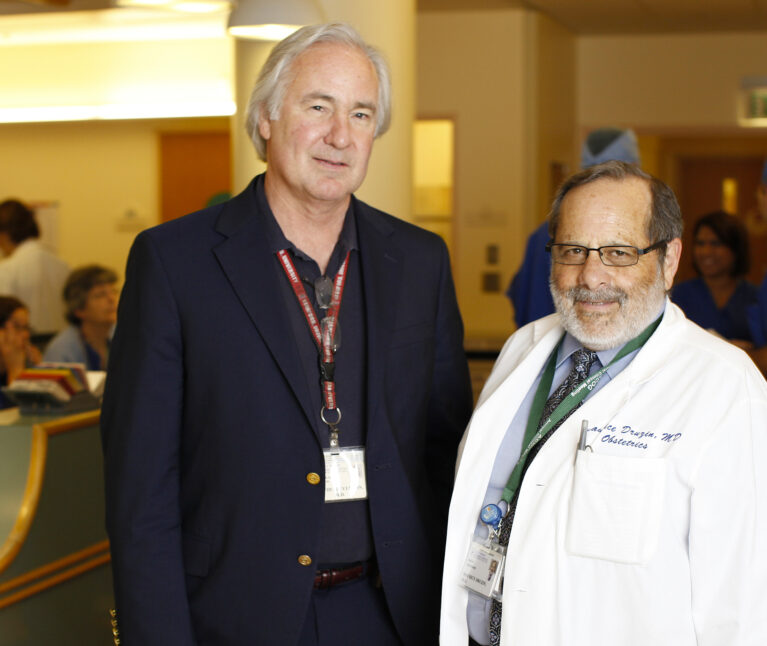When it comes to giving birth, where does the health of the expectant mother end and the care of the baby begin? At most hospitals, there is a distinct line between obstetrics—the surgical specialty that deals with the care of a woman during pregnancy and childbirth—and neonatology, a pediatric subspecialty that provides medical care for newborns, especially ill or premature babies.
But from its very beginning, Lucile Packard Children’s Hospital at Stanford has treated pregnancy and delivery as a continuous process, dissolving that line between caring for the adult patient and the newborn by integrating services dedicated to the health of both mother and baby.
Packard Children’s is the only children’s hospital in the Bay Area—and one of the few in the country—to combine obstetric and newborn services under one roof. Whether the pregnancy is high-risk or routine, care for mother and baby takes place as one continuous process that is immediate and focused. At Packard, the labor and delivery rooms and the nursery are just steps apart, and neonatal specialists are on hand for consultation or intervention during complicated births to provide a seamless transition for at-risk newborns.
“There has always been a close relationship between obstetrics and neonatology,” says Maurice Druzin, MD, the Charles B. and Ann L. Johnson Professor, chief of maternal-fetal medicine, and service chief of obstetrics and gynecology. “I came to Packard in 1991 with the intended purpose to strengthen that link and to establish the obstetrical component of a consolidated service.”
This integration of obstetrics and neonatology is a Packard trademark. The concept was built into the initial planning for a separate children’s hospital in the late 1970s, when labor and delivery still took place at Stanford Hospital. Services and administration were fully consolidated with the opening of Packard’s Charles B. and Ann L. Johnson Center for Pregnancy and Newborn Services in 1997.
“Obstetrical and neonatology services are highly interdependent by nature,” says Johnson Center director David Stevenson, MD, the Harold K. Faber Professor of Pediatrics. “Physical proximity is only a part of it. We have created a fully integrated network that simplifies the process of care for both patients and physicians.”
Packard Children’s ranks consistently among the best centers in the United States for its expertise in complicated pregnancies and for outcomes of premature infants. Critically ill mothers can be moved to the adjacent adult hospital if necessary, and babies born preterm or with a physical anomaly can be transferred immediately to the Neonatal Intensive Care Unit. For a new mother facing complications, that transition means a gurney roll down a hallway, not a transfer to another hospital. At-risk newborns stay close to their parents.
For all types of pregnancies, Packard Children’s provides one point of entry for family planning, prenatal tests, imaging, monitoring, genetic counseling, delivery options, and labor. With more than 500 affiliated obstetricians and neonatologists, the Hospital is internationally known for its ability to coordinate care and address the multitudes of medical concerns that can arise during pregnancy and delivery.
“Obstetrics and neonatology, by their very natures, require teams that know how to collaborate and connect,” says Druzin, who is also co-director of the Johnson Center. “By integrating the two specialties, we are able to streamline care for families, as well as create new opportunities for collaboration in clinical research.”
Pregnancy and the delivery of a newborn is part of a continuum of care for women and families, adds Jonathan S. Berek, MD, MMS, professor and chair of obstetrics and gynecology. “By providing comprehensive care to both mother and newborn, this close collaboration accommodates the very nucleus of the family and recognizes the needs of the pregnant woman, her baby, and the family that supports them,” he says. “It’s the ideal way to optimize our clinical care and our scientific endeavors, which can lead directly to improvements in the outcome of our patients.”
Druzin predicts even closer alignment of the two specialties as Packard Children’s refines its plans for expansion and renovation. In the coming years, private rooms are planned for all patients. And as new knowledge and improved technology enhance outcomes, additional services like reproductive endocrinology and infertility clinics may be incorporated more effectively, providing a unique opportunity to evaluate and influence pregnancy from conception to the newborn period.
“Bringing these services together makes perfect sense,” says Stevenson. “There is an inherent overlap of interests and outcomes. Both the mother and the infant are already right where they need to be.”
